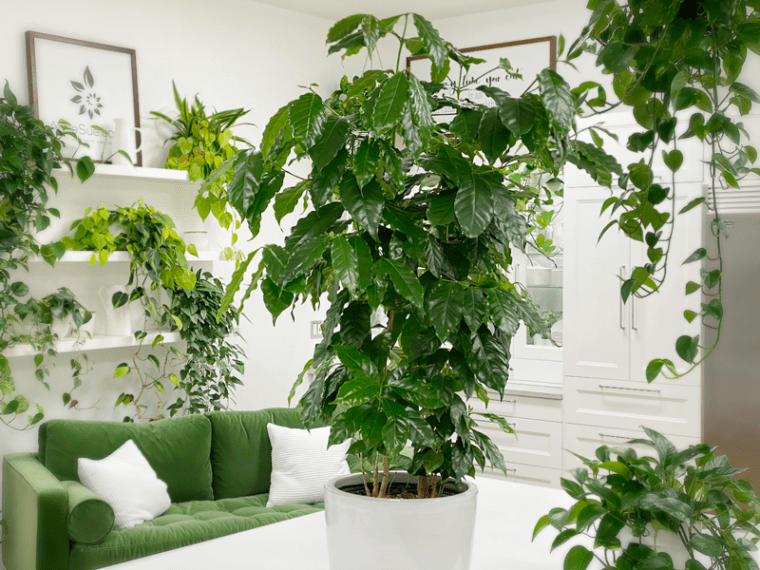Grow Your Own Coffee at Home to Discover the Remarkable Flavours!
Cover the Remarkable Flavours!
If you love both coffee and gardening, why not bring those passions together and grow your own coffee at home? Cultivating coffee plants indoors is a rewarding experience that not only enhances your green thumb but also lets you enjoy the unique satisfaction of brewing a cup made from beans you’ve nurtured yourself.

In this guide, we’ll cover the best coffee varieties for home cultivation, step-by-step indoor growing tips, tools you’ll need, and a timeline for harvesting your very first batch of homegrown beans.
Varieties of Coffee for Home Cultivation
When deciding which coffee to grow at home, two main species dominate:
- Coffea arabica (Arabica) – prized for its smooth, complex, and aromatic flavours.
- Coffea canephora (Robusta) – higher in caffeine, stronger in flavour, and more disease-resistant.
Both grow well indoors, but Arabica is typically the favourite for home growers thanks to its exceptional taste.
Popular Coffee Varieties to Grow at Home

Arabica Varieties
- Typica: Smooth, balanced flavour with mild acidity.
- Bourbon: Sweet and complex with rich flavour notes.
- Caturra: Compact Bourbon variety, ideal for indoor spaces.
- Geisha (Gesha): Floral, fruity, and highly aromatic—world famous for its profile.
- SL28 & SL34: Kenyan types, celebrated for vibrant acidity and brightness.
Robusta Varieties
- Robusta: Bold, full-bodied with high caffeine content.
- Nganda: Hardy Ugandan strain with excellent resistance.
- S274 (CXR): A superior Robusta variety with improved bean quality.
Essential Tools for Growing Coffee Indoors
While coffee plants don’t require complicated equipment, having the right tools makes cultivation easier and healthier for your plants:

- Pots & Containers with drainage holes
- Potting Mix (peat moss, perlite, compost blend)
- Grow Lights for low-light homes
- Humidity Tray or Humidifier to mimic tropical environments
- Pruning Shears for shaping and stimulating growth
- Fertilizer (balanced, diluted liquid formula every 6–8 weeks)
- Thermometer & Hygrometer to monitor conditions
Providing the right light, humidity, watering routine, and soil mix is far more important than having every tool.
Can You Grow Coffee Indoors?
Absolutely! Coffee plants can thrive indoors with the right care:
- Container: Spacious pot with good drainage
- Soil: Well-draining, slightly acidic mix
- Light: Bright, indirect light or grow lights
- Temperature: 60–70°F (15–24°C) with high humidity
- Watering: Keep soil evenly moist, but never soggy
- Fertilizing: Feed every 6–8 weeks in growing season
Time to Harvest
Growing coffee is a long-term project, but worth the wait:
- Year 1 – Germination and early leaves
- Year 2 – Stronger growth, branching encouraged
- Year 3 – Possible flowering begins
- Year 4+ – Pollination, cherry development, and harvesting
Indoor coffee plants may take slightly longer due to light and space limitations, but patience pays off.
Where to Buy Coffee Plants

- Local Nurseries & Garden Centers
- Online Plant Shops (check seller reviews)
- Specialty Coffee Shops promoting sustainable growing
- Plant Expos & Farmers’ Markets
- Online Marketplaces like Amazon, Etsy, and eBay
When to Plant Coffee at Home
Best times to start:
- Spring (March–May) – optimal growing conditions
- Early Summer (June–July) – still suitable if missed spring
These seasons provide the warmth and sunlight your coffee plant needs for strong early development.
Soil Requirements for Coffee Plants
For strong growth, coffee needs the right soil mix:
- Well-Draining (prevents root rot)
- Slightly Acidic pH (6–6.5)
- Organic Matter (compost for nutrients)
DIY Soil Mix: equal parts peat moss, perlite, compost, and coarse sand. Add mulch to lock in moisture and regulate soil temperature.
Watering & Fertilizing Coffee Plants
- Watering: Keep soil evenly moist, check the top inch for dryness before watering. Reduce frequency in winter.
- Fertilizing: Use a balanced water-soluble fertilizer (10-10-10 or 20-20-20), diluted to half strength every 6–8 weeks in spring/summer.
Organic alternatives include compost and well-rotted manure.
Common Pests & Diseases
Pests to Watch For: aphids, mealybugs, spider mites, scale, and whiteflies.
Diseases: coffee leaf rust, coffee berry disease, root rot, and bacterial blight.
Prevention Tips:
- Inspect plants regularly
- Provide proper spacing & air circulation
- Use neem oil or insecticidal soap for early infestations
- Avoid overwatering to reduce risk of root rot

Coffee Travel Guide: Best Cafés and Roasters Around the World.
For coffee lovers, exploring the world often means discovering unique cafés and specialty roasters. From local hidden gems to famous…

Sustainable Coffee: How to Drink Responsibly.
Sustainable Coffee: How to Drink Responsibly. Introduction Sustainable coffee isn’t just a trend it’s a movement that supports farmers, protects the environment,…
Coffee Storage Tips: Keeping Beans Fresh and Flavourful.
Coffee Storage Tips: Keeping Beans Fresh and Flavourful. Introduction Fresh coffee starts with proper storage. Even high-quality beans lose flavour and aroma…
Specialty Coffee Drinks: Lattes, Cortados, and More Explained.
Coffee culture isn’t just about black coffee it’s also about specialty drinks that combine espresso, milk, foam, and ………………. Read…
Coffee and Sleep: How to Enjoy Your Brew Without Insomnia.
Coffee can be a lifesaver in the morning, but drinking it at the wrong time can disrupt sleep and impact…
Healthy Coffee Habits: Enjoy Your Brew Without the Guilt.
Healthy Coffee Habits: Enjoy Your Brew Without the Guilt Introduction Coffee can be one of life’s greatest pleasures, but many people worry…
Author

Brendon McAliece has spent more than 45 years immersed in a passion for coffee, exploring beans, brewing traditions, and café cultures across the globe. A multilingual expat fluent in Thai, three Thai dialects, Lao, and European languages, he values the role of coffee and language in building cultural connection.
His diverse background also includes over three decades in flight simulation and PC building, alongside two decades of service as a jet fighter weapons and egress technician.
Learn more @
DreamingGuitar.com – DreamingCoffee.com – LetsFlyVFR.com
Home – Blog – Shop – About
As an Amazon affiliate I may earn on qualifying sales.






